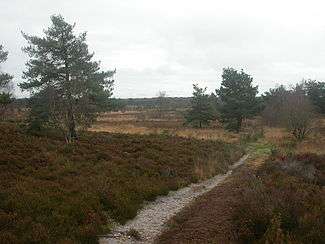Parley Common
| Parley Common | |
|---|---|
|
Example of the heath, widespread on Parley Common | |
| Type | Heath |
| Location | Dorset, England |
| Nearest town | Ferndown |
| Coordinates | 50°47′05″N 1°52′52″W / 50.784801°N 1.88121°WCoordinates: 50°47′05″N 1°52′52″W / 50.784801°N 1.88121°W |
| Area | 168.1 hectares (415 acres) |
| Status | SSSI |
Parley Common is a Site of Special Scientific Interest (SSSI) on the edge of Ferndown in Dorset, England.[1] The majority land owner is the Canford Estate, but among the other owners are the Diocese of Salisbury, Dorset County Council, East Dorset District Council and a few private individuals.[2] Most of the site is managed by the Amphibian and Reptile Conservation Trust (ARC); East Dorset Countryside Management Service manage the area owned by East Dorset District Council and Dorset Countryside manage the area owned by Dorset County Council.[2] The site was notified as an SSSI in 1983.[1]
The area of the site is 168.1 hectares (415 acres), and comprises a significant amount of heath; the northern and western parts are primarily of the dry heath Calluna vulgaris and Erica cinerea, while the low-lying parts of the south-east are mostly the damp or humid heath Erica tetralix and Molinia caerulea.[1] Rare heathland species include the sand lizard (Lacerta agilis), smooth snake (Coronella austriaca), heath grasshopper (Chorthippus vagansand) and the Dartford warbler (Sylvia undata).[1] Parley Common has an abundance of spider fauna—at least 147 species—which includes the very rare Ero aphana, Xysticus robustus—otherwise found in only a few places in the New Forest—and Gnaphosa lugubris.[1] The site holds claim to a number of firsts: the smooth snake was first recorded in Britain in Parley Common in 1853; the Mazarine blue (Cyaniris semiargus)—now extinct in Britain—was first discovered here in the late nineteenth century; the moth Pachythelia villosella and the ringed carpet moth (Cleora cinctaria) were also first discovered here.[2]
The site is one of many areas in the South East Dorset in which grazing by cattle has been reintroduced, as part of efforts to control the growth of scrub.[2][3] Arson and illegal vehicle use have caused damage to the site,[4] although community involvement is thought to have lessened the number of incidents.[5]
See also
References
- 1 2 3 4 5 "Parley Common (SSSI citation)" (PDF). Natural England. Retrieved 24 March 2013.
- 1 2 3 4 "Parley Common". Dorset County Council. Retrieved 24 March 2013.
- ↑ "Conservation Grazing on SE Dorset's Urban Nature Reserves". Dorset Wildlife Trust. Retrieved 24 March 2013.
- ↑ "Parley Common Guide Map". Dorset County Council. Retrieved 24 March 2013.
- ↑ Riley, Stephen. "From Trickett's Cross to Heatherlands". Dorset Life. Retrieved 24 March 2013.
External links
- Dorset Heathlands list published by the Joint Nature Conservation Committee (JNCC).
- Dorset Nature Reserves of the ARC.
- Nature on the Map by Natural England.
- "The Dorset Heathlands Planning Framework 2012-2014: Supplementary Planning Document Consultation Draft". (631 KB) by Poole Borough Council.
